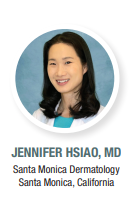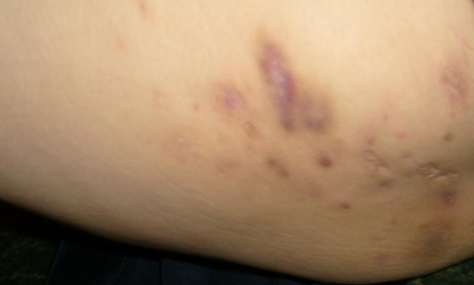With Jennifer Hsiao, MD
Products under investigation represent diverse targets

“Much research remains to be done to better elucidate the pathophysiology of hidradenitis suppurativa (HS), but it is exciting that the investigational pipeline includes multiple biologic agents because it provides hope for having more therapeutic options to offer patients suffering from this disease,” said Jennifer Hsiao, MD, a dermatologist at Santa Monica Dermatology, Santa Monica, California.
“Hopefully in the future, we will be personalizing therapy selection based on clinical phenotypes or biomarkers. Even then and certainly at present, we need to remember that HS can be driven by genetic, hormonal, microbiome-related, and/or immune dysregulation factors. Stacking treatments to address multiple contributing mechanistic pathways rather than relying on a single agent will hopefully provide synergistic efficacy.”
Biologic round-up
In 2015, adalimumab (Humira, AbbVie; Lake Bluff, IL) gained FDA approval as the first biologic treatment for HS. However, not all patients respond to adalimumab, and for a variety of known and unknown reasons, others may lose efficacy over time.
Thus, the search for biologic options to treat HS has continued. Case reports and retrospective case series suggest utility for a number of commercially available biologic agents aimed at a variety of inflammatory pathways. Those compounds and investigational biologics are being evaluated in clinical trials (Table).
“The number of targets reflects the lack of understanding about which cytokines and molecules are the predominantly important ones in HS pathogenesis, and whether the answer may differ across patients” Dr. Hsiao said.
The IL-17 blocker secukimumab (Cosentyx, Novartis; Basel, Switzerland) is now being investigated in two phase 3 trials. Elevated levels of IL-17 in the serum and in lesional and perilesional skin of HS patients provide a rationale for investigating secukinumab.
“Having a second approved biologic agent to treat HS that has a different mechanism of action than adalimumab would be valuable, especially considering that certain patients are not appropriate candidates for an anti-TNFa agent,” said Dr. Hsiao.
IL-12/23 inhibition is also being pursued based on findings that those cytokines are overly expressed in the lesional skin of HS patients. A small open-label study reported the benefit of ustekinumab (Stelara, Janssen Pharmaceuticals; Beerse, Belgium) in 82% of patients.
According to Dr. Hsiao, “Subsequent data from case reports and series have suggested that higher and more frequent doses of ustekinumab, with the administration of the first dose by intravenous infusion, may provide greater benefit. More studies in larger populations are needed.”

Agents blocking only IL-23 are also under investigation based on the idea that IL-23 may be the more significant player in pathogenesis. In this category, guselkumab (Tremfya, Janssen Pharmaceuticals) completed a phase 2 trial, and a phase 2 study of risankizumab (Skyrizi, AbbVie) is underway.
“These trials will give us a better idea about whether targeting the IL-12/23 or IL-23 pathways are worthy of further study. In my personal limited experience, they appear promising,” Dr. Hsiao said.
Based on several lines of evidence that neutrophils and the complement pathway contribute to HS, the anti-C5a antibody IFX-1(vilobelimab, inflaRx; Urbandale, IA) is also being studied as a treatment for HS. An early open-label study reported an 83% response after 3 months among patients with severe disease. More recently, a phase 2b trial failed to meet its primary endpoint, but benefit was seen in analysis of secondary endpoints.
The anti-IL-1a monoclonal antibody bermekimab (Janssen) is being studied in a large phase 2 trial that includes adalimumab as a comparator. Spesolimab (Boehringer Ingelheim International GmbH; Ingelheim, Germany), an IL-36 blocker, is being investigated in a placebo-controlled phase 2 study aiming to enroll 45 patients.
“IL-36 is a novel target, and patient responses to spesolimab will provide some insight on how important it is in the pathogenic pathway for HS,” Dr. Hsiao said. “Exciting developments are underway in the field of HS, which will hopefully ultimately translate into effective tailored treatment regimens to help ease the suffering of our patients in need.”
By Cheryl Guttman
DISCLOSURE
Dr. Hsiao is on the Board of Directors for the Hidradenitis Suppurativa Foundation. She is a speaker for AbbVie and a consultant for Novartis.

